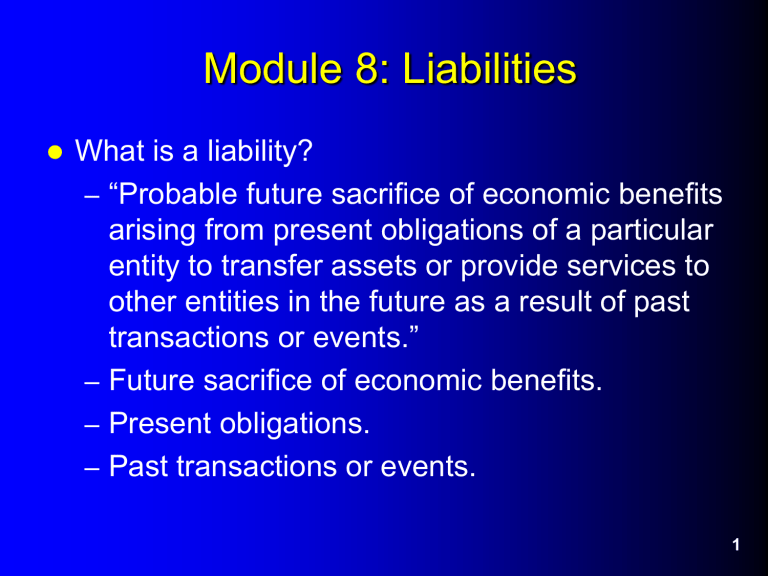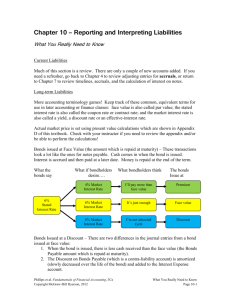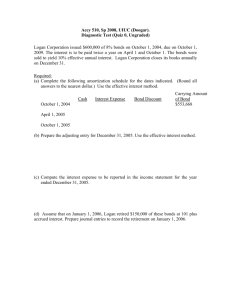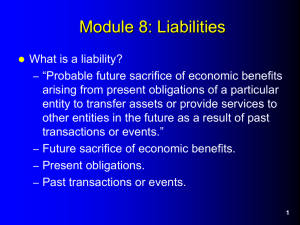Chapter 10 Instructor
advertisement

Module 8: Liabilities What is a liability? – “Probable future sacrifice of economic benefits arising from present obligations of a particular entity to transfer assets or provide services to other entities in the future as a result of past transactions or events.” – Future sacrifice of economic benefits. – Present obligations. – Past transactions or events. 1 Current Liabilities Classification – expected to require the use of current assets (or the creation of other current liabilities) to settle the obligation. Valuing current liabilities on the balance sheet – Ignore present value – Report at face value Reporting current liabilities – Primary problem is ensuring that all existing current liabilities are reported on the balance sheet. 2 Current Operating Liabilities 1. Accounts payable - for purchase of goods and services (usually no interest). A/P Turnover = COGS/Avg. Acct. Pay A/P Days Out. =Acct. Pay./Avg. Daily COGS 2. Accrued liabilities - short-term payables usually settled with cash in the near future. Ex: Wages, Interest, Income Tax, Utilities, Vacation Pay, Bonuses, Property Taxes. 3. Unearned revenues - usually settled with delivery of goods and services. 4. Estimated accruals - amounts not known at the end of the period and must be estimated. Ex: Warranties. 3 Warranties Companies generate sales revenue when they sell products; offering warranties is part of the cost of selling the product; the amount of the future warranty costs is not known, but may be estimated. – Record estimated expense and liability when products are sold (matching concept): Warranty Expense xx Estimated Warranty Liability xx – As costs are incurred (usually in subsequent periods), charge expenditure to warranty liability: Estimated Warranty Liability xx Cash, etc. xx Note: warranties, like other estimates, may be subject to manipulation. 4 Lawsuits What about lawsuits where the company is the defendant? Should we accrue for the possible future liability? Only if the settlement is “probable” and “reasonably estimable”. Since the criteria are vague, and legal staff can usually find sufficient evidence to indicate some level of probability that the defendant will prevail, estimated liabilities for lawsuits are rarely recorded. However, most lawsuits meet the minimum requirement of “reasonably possible” and must be disclosed in the notes to the financials; these disclosures inform investors as to the potential exposure. Most companies have a section for “Contingencies” in their footnotes. 5 Current Non-Operating Liabilities Short-Term Interest-Bearing Debt borrowing from bank is a financing activity, and not part of operations. Current Portion of Long-Term Debt - the portion of long-term liabilities, like bonds and mortgages, that will come due within the next 12 months (as of the financial statement date), will require the use of current assets (specifically cash) to settle the liabilities; these liabilities must be classified as current liabilities. 6 Long-Term Liabilities: Bonds Payable Long-term liabilities are initially recorded at the present value of the future cash flows. The subject of calculation of present value is covered in Appendix 8A, and present value tables are included in Appendix A at the back of the book. These tables will be supplied with Exam 1 if you choose to use them. 7 Present Value Concepts Appendix 8A (pages 28-33) The value of a dollar today will decrease over time. Why? Two components determine the “time value” of money: – interest (discount) rate – number of periods of discounting For financial reporting, we are concerned primarily with present value concepts. 8 Present Value Concepts To record activities in the general ledger dealing with future cash flows, we should calculate the present value of the future cash flows using present value formulas or techniques. Types of activities that require PV calculations: – long-term notes payable – bonds payable and bond investments – capital leases (Module 10) 9 Types of Present Value Calculations PV of a single sum (PV1): discounting a future value of a single amount that is to be paid in the future (ex: face value of bonds payable). PV of an ordinary annuity (PVOA): discounting a set of payments, equal in amount over equal periods of time, where the first payment is made at the end of each period (ex: interest on bonds payable). PV of an annuity due (PVAD): discounting a set of payments, equal in amount over equal periods of time, where the first payment is made at the beginning of each period (ex: lease payments) more on this in Module 10. 10 Present Value of a Single Sum All present value calculations presume a discount rate (i) and a number of periods of discounting (n).There are 3 different ways you can calculate the PV1: n 1. Formula: PV1 = FV1 [1/(1+i) ] 2. Tables: see page A2, Table 1 PV1 Table PV1 = FV1( ) i, n 3.Calculator (if you have time value functions). 11 Long-term Notes Payable Usually issued to financial institutions. May be interest bearing or non-interest bearing (we will look at non-interest bearing). May be serial notes (periodic payments) or term notes (balloon payments). We will look at balloon payments here. Note: zero coupon bonds are similar in treatment to non-interest bearing notes. Illustration 1: On January, 2, 2013, Pearson Company purchases a section of land for its new plant site. Pearson issues a 5 year non-interest bearing note, and promises to pay $50,000 at the end of the 5 year period. What is the cash equivalent price of the land, if a 6 percent discount rate is assumed? 12 Illustration1 Solution See page A2, Table 1 PV1 Table PV1 = FV1( ) i, n PV1 Table i=6%, n=5 Journal entry Jan. 2, 2013: 13 Illustration1 Solution, continued What amount would be recognized for interest expense at December 31, 2013? In this chapter we will use the effective interest method to calculate interest expense. The formula for interest is: Interest Expense = Carrying value x interest rate x time period (CV) (per year) (portion of yr.) Where carrying value = face - discount. For Example 1, CV at Dec. 31 before amortization? CV = 50,000 - 12,637 = 37,363 Int. expense = 37,363 x .06 per yr. x 1yr. = 2,242 14 Illustration1 Solution, continued Journal entry, December 31, 2013: Carrying value on B/S at 12/31/2013? (Discount = 12,637 - 2,242 = 10,395) 15 Illustration 1 Solution, continued Interest expense at Dec. 31, 2014: 39,605 x .06 x 1 = $2,376 Journal entry, December 31, 2014: Carrying value on B/S at 12/31/2014? (Disc.=10,395-2,376) Carrying value on 12/31/2017 (before retirement)? 16 2. Present Value of an Ordinary Annuity (PVOA) An annuity is defined as equal payments over equal periods of time. An ordinary annuity assumes that each payment occurs at the end of each period. PVOA calculations presume a discount rate (i), where (A) = the amount of each annuity, and (n) = the number of annuities (or rents), which is the same as the number of periods of discounting. There are 3 different ways you can calculate PVOA: n 1. Formula: PVOA = A [1-(1/(1+i) )] / i 2. Tables: see page A-2, Table 2 PVOA Table PVOA = A( ) i, n 3.Calculator (if you have time value functions). 17 Bonds Payable Bonds payable are issued by a company (usually to the marketplace) to generate cash flow. The bonds represent a promise by the company to pay a stated interest each period (yearly, semiannually, quarterly), and pay the face amount of the bond at maturity. The marketplace values bonds by discounting the cash flows using the market rate of interest. This is also called the yield rate, discount rate, or effective rate. There are two types of cash flows with bonds: PVOA and PV1. 18 Illustration 2: Bonds Payable On July 1, 2013, Mustang Corporation issues $100,000 of its 5 year bonds which have an annual stated rate of 7%, and pay interest semiannually each June 30 and December 31, starting December 31, 2013. The bonds were issued to yield 6% annually. Calculate the issue price of the bond: What are the cash flows and factors? (1) Face value at maturity = $100,000 (2) Stated Interest = Face value x stated rate x time period 100,000 x .07 x 1/2 = $3,500 Number of periods = n = 5 yrs x 2 = 10 Discount rate = 6% / 2 = 3% per period 19 Illustration 2 - Solution PV of interest annuity: PVOA Table PVOA = A( PVOA Table ) = 3,500 (8.53020) = $29,856 i, n i = 3%, n = 10 PV of face value: PV1 Table PV =FV1( PV1 Table ) = 100,000(0.74409)=$74,409 i, n Total issue price = i=3%, n=10 $104,265 Issued at a premium of $4,265 because the company was offering an interest rate greater than the market rate, and investors were willing to pay more for the higher interest rate. 20 Illustration 2 - Amortization Schedule To recognize interest expense using the effective interest method, an amortization schedule must be constructed. To calculate the columns (see next slide): Cash paid = Face x Stated Rate x Time = 100,000 x .07 x 1/2 year = $3,500 (this is the same amount every period) Int. Expense = CV x Market Rate x Time at 12/31/13 = 104,265 x .06 x 1/2 year = 3,128 at 6/30/14 = 103,893 x .06 x 1/2 year = 3,117 The difference between cash paid and interest expense is the periodic amortization of premium. Note that the carrying value is amortized down to face value by maturity. 21 Illustration 2 - Amortization Schedule Date 7/01/13 12/31/13 6/30/14 12/31/14 6/30/15 12/31/15 6/30/16 12/31/16 6/30/17 12/31/17 6/30/18 Cash Paid 3,500 3,500 3,500 3,500 3,500 3,500 3,500 3,500 3,500 3,500 Interest Expense 3,128 3,117 3,105 3,093 3,081 3,069 3,056 3,042 3,029 3,015 Carrying Difference Value 104,265 372 103,893 383 103,510 395 103,115 407 102,708 419 102,289 431 101,858 444 101,414 458 100,956 471 100,485 485 100,000 22 Illustration 2 - Journal Entries JE at 7/1/13 to issue the bonds: JE at 12/31/13 to pay interest: Note that the numbers for each interest payment come from the lines on the amortization schedule. 23 Bonds Payable at a Discount. If bonds are issued at a discount, the carrying value will be below face value at the date of issue. The Discount on B/P account has a normal debit balance and is a contra to B/P (similar to the Discount on N/P). The Discount account is amortized with a credit. Note that the difference between Cash Paid and Interest Expense is still the amount of amortization. Interest expense for bonds issued at a discount will be greater than cash paid. The amortization table will show the bonds amortized up to face value. 24 Illustration 3: Bonds Payable (Discount) On January 1, 2013, Corvette Corporation issues $100,000 of its 5 year bonds which have an annual stated rate of 5%, and pay interest annually each December 31, starting December 31, 2013. The bonds were issued to yield 6% annually. Calculate the issue price of the bond: What are the cash flows and factors? (1) Face value at maturity = $100,000 (2) Stated Interest = Face value x stated rate x time period 100,000 x .05 per yr x 1 yr. = $5,000 Number of periods = n = 5 yrs Discount rate = 6% per year 25 Illustration 3 : Present Value Calculations PV of interest annuity: PVOA Table PVOA = A( PVOA Table )= i, n i = 6%, n=5 PV of face value: PV1 Table PV =FV1( PV1 Table )= i, n I = 6%, n=5 Total issue price = Issued at a discount of $4,212 because the company was offering an interest rate less than the market rate, and investors were not willing to pay as much for the lower interest rate. 26 Illustration 3 : Journal Entry at Issue JE at 1/1/06 to issue the bonds: Discount on Bonds Payable is located in the liability section of the balance sheet, as a contra, and offsets Bonds Payable. On the balance sheet at 1/1/13: Liabilities Bonds Payable Discount on B/P (the carrying value is 95,788) 27 Illustration 3 : Journal Entry to Pay Interest JE at 12/31/13 to pay interest: Calculations first: Cash paid=Face x stated rate x time = = 100,000 x .05 x 1 yr. = $5,000 Interest expense = CV x market rate x time = = 95,788 x .06 x 1 yr = $5,747 (rounded) Amortization of discount = difference (plug) = 5,747 – 5,000 = 747 (credit) Now journal entry: 28 Early Retirement of Bonds Bonds are retired when the company pays the investors the amount owed. If bonds are held to maturity, the amount on the books is face value and the amount paid is face value. If bonds are retired before maturity, the amount on the books is the carrying value, and the amount paid is the market value at the point of retirement. Because these two amounts are seldom the same, a gain or loss must be recognized. 29 Retirement of Bonds The gain or loss is the difference between carrying value and cash paid. – If cash paid is greater than CV, recognize loss (paid more than book liability). – If cash paid is less than CV, recognize gain (paid less than book liability). The gain or loss is recognized as part of Income from Continuing Operations (Other Revenues and Gains or Other Expenses and Losses). Note that the gain or loss does not represent an economic event; it is simply an adjustment to book value at the time of retirement to reflect the market value of the debt. 30






